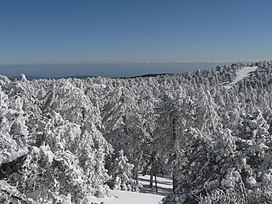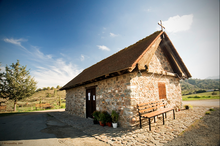| Troodos | |
|---|---|
| Troödos | |
 Trees of Mount Olympus Trees of Mount Olympus | |
| Highest point | |
| Peak | Mount Olympus |
| Elevation | 1,952 m (6,404 ft) |
| Coordinates | 34°55′N 32°50′E / 34.917°N 32.833°E / 34.917; 32.833 |
| Naming | |
| Native name | |
| Geography | |
| Country | Cyprus |
Troodos or Trodos is the largest mountain range in Cyprus, located in roughly the center of the island. Its highest peak is Mount Olympus – also known in Greek as Χιονίστρα – at 1,952 metres (6,404 ft).
Covering a third of Cyprus's area, the Troodos mountain range stretches across most of the western side of Cyprus. The mountains form a significant rainshadow on the island. There are many mountain resorts, Byzantine monasteries, and churches on mountain peaks, and, nestling in its valleys and mountains, villages which cling to terraced hills. The area has been known since antiquity for its mines, which for centuries supplied copper to the entire Mediterranean. In the Byzantine period it became a centre of Byzantine art, as churches and monasteries were built in the mountains, away from the threatened coastline.
The mountains are home to RAF Troodos, a listening post for both the American National Security Agency and the British GCHQ.
The name Troodos probably comes from one of two sources: either τρία + ὁδός (tría + hodós), referring to the three roads that lead to the mountain, or τό + ὄρος + Ἄδος (to + oro + Ados), meaning the mountains of Adonis.
It has many endemic plants and animals, including the endemic Cyprus cedar.
Geology

The Troodos Mountains are known for the presence of an undisturbed ophiolite sequence, the Troodos Ophiolite. These mountains slowly rose from the sea due to the collision of the African and European tectonic plates, a process that eventually formed the island of Cyprus. The slowing and near-cessation of this process left the rock formations nearly intact, while subsequent erosion uncovered the magma chamber underneath the mountain, allowing a viewing of intact rocks and petrified pillow lava formed millions of years ago, an excellent example of ophiolite stratigraphy. The observations of the Troodos ophiolite by Ian Graham Gass and co-workers was one of the key points that led to the theory of sea floor spreading. A detailed descriptive geological survey of Troodos was published in 1959. It predates the modern theory of plate tectonics, but contains exhaustive descriptions of rocks and structures.
Climate
Like the rest of Cyprus, the climate is Mediterranean but with somewhat greater diurnal ranges in temperature than coastal locations. For example, at Prodromos, daily mean temperatures are around −8 °C (18 °F) in January and 22 °C (72 °F) in July.
| Climate data for Prodromos in Troodos Mountains, elevation: 1380 m (Satellite view) | |||||||||||||
|---|---|---|---|---|---|---|---|---|---|---|---|---|---|
| Month | Jan | Feb | Mar | Apr | May | Jun | Jul | Aug | Sep | Oct | Nov | Dec | Year |
| Mean maximum °C (°F) | 13.3 (55.9) |
13.9 (57.0) |
18.5 (65.3) |
24.7 (76.5) |
27.9 (82.2) |
30.6 (87.1) |
32.2 (90.0) |
32.2 (90.0) |
30.2 (86.4) |
26.6 (79.9) |
20.1 (68.2) |
14.3 (57.7) |
32.2 (90.0) |
| Mean daily maximum °C (°F) | 6.3 (43.3) |
6.6 (43.9) |
10.3 (50.5) |
15.1 (59.2) |
20.5 (68.9) |
25.0 (77.0) |
28.1 (82.6) |
27.9 (82.2) |
24.4 (75.9) |
19.6 (67.3) |
12.8 (55.0) |
8.0 (46.4) |
17.1 (62.8) |
| Daily mean °C (°F) | 3.5 (38.3) |
3.5 (38.3) |
6.6 (43.9) |
10.7 (51.3) |
15.8 (60.4) |
20.1 (68.2) |
23.3 (73.9) |
23.1 (73.6) |
19.6 (67.3) |
15.4 (59.7) |
9.5 (49.1) |
5.3 (41.5) |
13.0 (55.4) |
| Mean daily minimum °C (°F) | 0.7 (33.3) |
0.3 (32.5) |
2.8 (37.0) |
6.3 (43.3) |
11.1 (52.0) |
15.2 (59.4) |
18.4 (65.1) |
18.2 (64.8) |
14.9 (58.8) |
11.3 (52.3) |
6.2 (43.2) |
2.5 (36.5) |
9.0 (48.2) |
| Mean minimum °C (°F) | −4.5 (23.9) |
−5.2 (22.6) |
−2.6 (27.3) |
0.5 (32.9) |
4.7 (40.5) |
9.2 (48.6) |
13.5 (56.3) |
14.0 (57.2) |
10.1 (50.2) |
5.4 (41.7) |
0.1 (32.2) |
−2.8 (27.0) |
−5.2 (22.6) |
| Average precipitation mm (inches) | 133.4 (5.25) |
123.6 (4.87) |
82.3 (3.24) |
56.9 (2.24) |
26.0 (1.02) |
40.0 (1.57) |
12.1 (0.48) |
10.0 (0.39) |
9.5 (0.37) |
24.0 (0.94) |
102.5 (4.04) |
169.7 (6.68) |
790.1 (31.11) |
| Average precipitation days (≥ 1 mm) | 12.4 | 11.2 | 9.8 | 6.7 | 3.7 | 2.1 | 0.7 | 0.7 | 1.4 | 3.5 | 7.4 | 11.2 | 70.7 |
| Mean monthly sunshine hours | 130.2 | 150.8 | 195.3 | 231.0 | 275.9 | 315.0 | 328.6 | 310.0 | 255.0 | 220.1 | 165.0 | 136.4 | 2,713.3 |
| Source: Meteorological Service (Cyprus) | |||||||||||||
Flora and fauna
The most ubiquitous trees in the Troodos mountains are the Turkish pine (Pinus brutia) and the golden oak (Quercus alnifolia). Some plants of the Olea, Rhus and Rosa genera populate the mountains, in particular Crataegus azarolus, Crataegus monogyna, Rhus coriaria and Rosa canina.

At higher altitudes, Anatolian black pine-dominated forests (Pinus nigra ssp. Pallasiana) grow, with several Juniperus species (J. excelsa, J. foetidissima and J. oxycedrus). The common whitebeam (Sorbus aria) also grows, along with the endemic shrubs Rosa chionistrae and Berberis cretica. The Cyprus cedar (Cedrus libani subsp. brevifolia) is seen at the highest peaks.
Chief among the fauna is the endangered Cyprus mouflon (Ovis gmelini ophion). The venemous Cypriot blunt-nosed viper (Macrovipera lebentinus lebentinus) is present in the mountains, as well as a bird population including the common raven (Corvus corax), Bonelli's eagle (Hieraaetus fasciatus), Red crossbill (Loxia curvirostra) and the Eurasian griffon vulture (Gyps fulvus).
Churches
Further information: Painted Churches in the Troödos Region

The region is known for its many Byzantine churches and monasteries, richly decorated with murals, of which the Kykkos monastery is the richest and most famous. Nine churches and one monastery in Troodos together form a World Heritage Site, originally inscribed on the World Heritage List by UNESCO in 1985. The nine Byzantine churches are:
- Stavros tou Agiasmati
- Panagia tou Araka
- Timiou Stavrou at Pelendri
- Agios Nikolaos tis Stegis
- Panagia Podithou
- Assinou
- Agios Ioannis Lampadistis at Kalopanagiotis
- Panagia tou Moutoula
- Archangel Michael at Pedoulas
- Transfiguration of the Saviour Palaichori
Selected villages

- Agros
- Agios Epifanios Oreinis
- Arsos
- Dora
- Evrychou
- Farmakas
- Fikardou
- Galata
- Kakopetria
- Kalopanagiotis
- Koilani
- Kouka
- Kourdali
- Kyperounta
- Lania
- Louvaras
- Malia
- Marathassa Valley
- Moutoullas
- Omodos
- Pachna
- Palaichori Oreinis
- Pedoulas
- Pelendri
- Phini
- Platres
- Prastio
- Prodromos
- Spilia
- Vasa Koilaniou
Gallery
-
 Troodos Mountains
Troodos Mountains
-
Lazanias village
-
 Troodos black pines are 3,000 years old
Troodos black pines are 3,000 years old
-
Forests in Troodos Mountains
-
 Pinus brutia, foothills of Troodos Mountains
Pinus brutia, foothills of Troodos Mountains
-
 River tributary in Troodos
River tributary in Troodos
-
 Parakentro is a non-profit cultural centre in Lemythou village
Parakentro is a non-profit cultural centre in Lemythou village
-
Millomeris Waterfall, Platres
-
Milia Bridge, Platres
-
 Tzielefos bridge
Tzielefos bridge
-
 The statue of Archbishop Makarios III near the Kykkos Monastery
The statue of Archbishop Makarios III near the Kykkos Monastery
-
 Omodos
Omodos
-
Kalidonia Waterfall, Platres
-
Part of Troodos Mountains
-
 View of Farmakas region
View of Farmakas region
-
 Prodromos in winter
Prodromos in winter
-
 Road through the forest
Road through the forest
-
 Troodos Mountains in 1957
Troodos Mountains in 1957
See also
Notes
- Greek: Τρόοδος [ˈtɾo.oðos]; Turkish: Trodos Dağları ['tɾo.dos]
References
- Haub, Gangolf. "Olympos (Chionistra)". SummitPost. Retrieved 2025-01-10.
- ^ "Troodos Mountains - Mount Olympus". Cyprus Alive. Retrieved 2025-01-10.
- Ring, Uwe; Pantazides, Hermes (August 2019). "The Uplift of the Troodos Massif, Cyprus". Tectonics. 38 (8): 3124–3139. doi:10.1029/2019TC005514. Retrieved 2025-01-08.
- "Cyprus Travel Series: Troodos Mountains". Expand Your Property World. 2017-11-23. Retrieved 2018-02-16.
- Cora Currier; Henrik Moltke (January 29, 2016). "Spies in the sky". The Intercept.
- "Places to visit - Troodos Cyprus". www.justaboutcyprus.com. Archived from the original on 2017-12-16. Retrieved 2017-09-18.
- "Snowy Mountains of Troodos - December at Olympos - Chionistra". www.cyprusalive.com. Retrieved 2017-09-18.
- Breen, Patrick. "Cedrus libani subsp. brevifolia". Landscape Plants. Oregon State University. Retrieved 2025-01-10.
- Papanikolaou, Dimitrios I. (2021). The Geology of Greece. Cham, Switzerland: Springer. p. 12. ISBN 978-3-030-60730-2.
- Wilson, R.A.M. The Geology of the Xeros-Troodos Area: Geological Survey Department, cyprus, Memoir No. 1. Nicosia, Cyprus: Government of Cyprus, Ministry of Agriculture and Natural Resources, 1959, reprinted 1971.
- "Climatological and Meteorological Reports - Prodromos - 1991 - 2005" (PDF). Archived from the original (pdf) on 2016-03-27. Retrieved 2017-06-29.
- "Rosa chionistrae H.Lindb.". Plants of the World Online. Royal Botanic Gardens, Kew. Retrieved 2025-01-10.
External links
- Official Website of Troodos Region, by the Cyprus Tourism Organisation
- Troodos (General Area) Museums
- Panoramic virtual tour of the Troodos Mountains Archived 2009-06-03 at the Wayback Machine
- Kypros Net article on Troodos
- Awarded "EDEN – European Destinations of Excellence" non traditional tourist destination 2007
